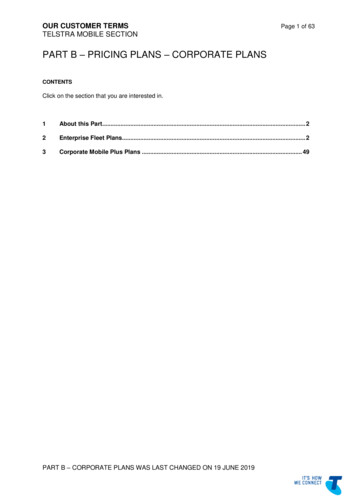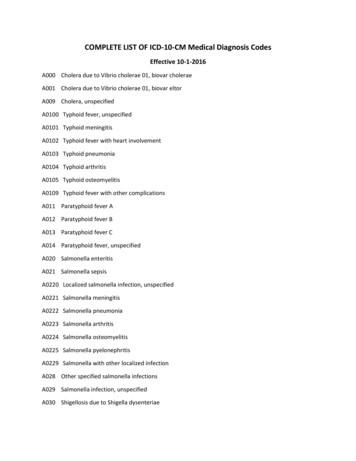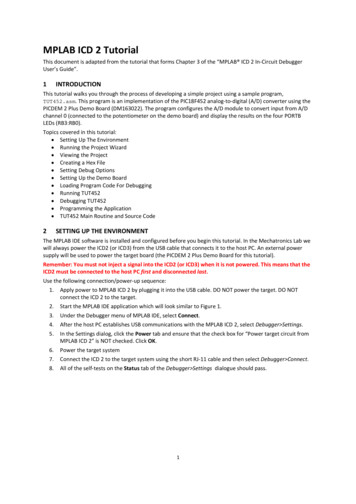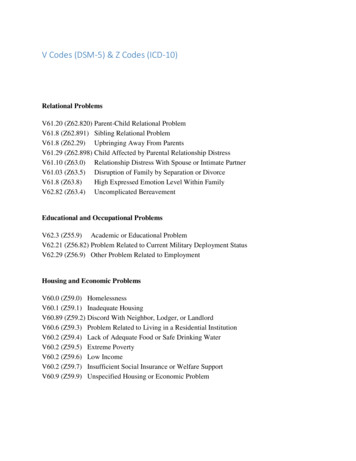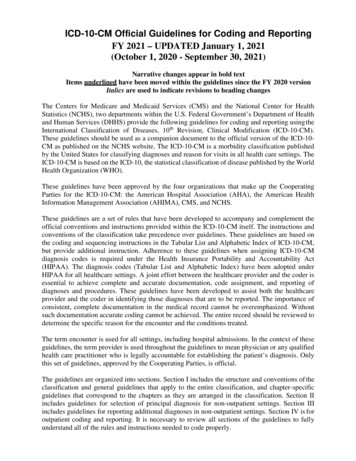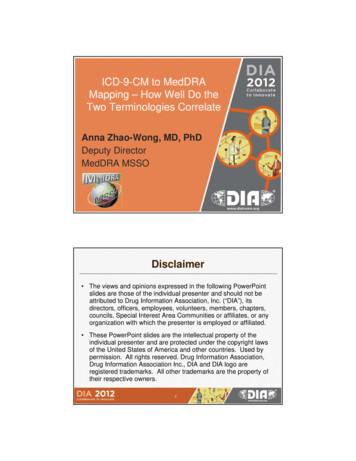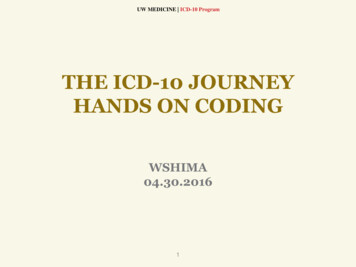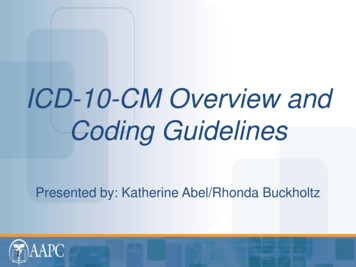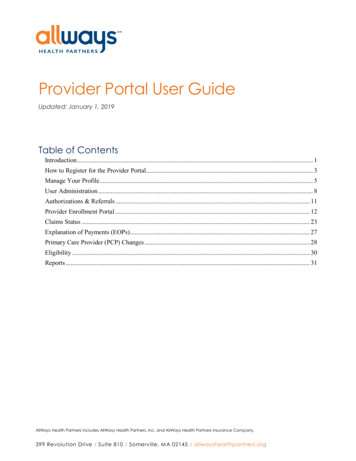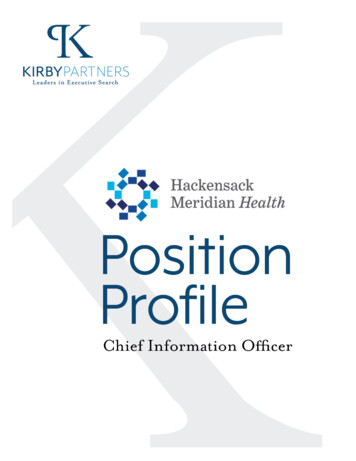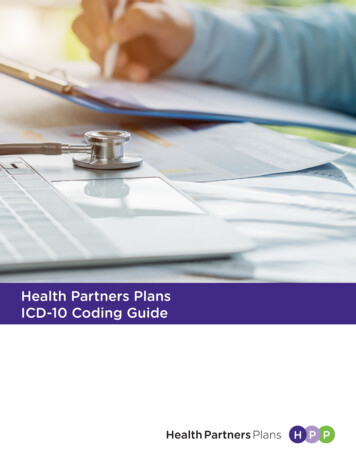
Transcription
Health Partners PlansICD-10 Coding Guide
The codes listed are ICD-10 diagnosis codes that are most commonly used and billed forby providers but lack specificity. Use this guide to further specify the condition of themember. Medical record documentation should accurately match the diagnosis codesbeing billed for.For more coding information, please contact Christina Rock, Supervisor, Clinical Education,at crock@hpplans.com.
d/NOS J45.20Persistent,uncomplicated/NOS J45.30Persistent,uncomplicated/NOS J45.40Persistent,uncomplicated/NOS J45.50Intermittent, withacute exacerbationJ45.21Persistent, withacute exacerbationJ45.31Persistent, withacute exacerbationJ45.41Persistent, withacute exacerbationJ45.51Intermittent, withstatus asthmaticsJ45.22Persistent, withstatus asthmaticsJ45.32Persistent, withstatus asthmaticsJ45.42Persistent, withstatus asthmaticsJ45.52When documenting asthma, include the following:1. Cause – Exercise induced, cough variant, related to smoking, chemical or particulatecause, occupational2. Severity – Choose one of the three: mild, moderate or severe3. Temporal Factors – Acute, chronic, intermittent, persistent, status asthmatics,acute exacerbation
Type II Diabetes Mellitus E11Type II with KidneyComplications E11.2*Use additional code toidentify stage of CKDType II with OphthalmicComplications E11.3NonProliferativeRetinopathyType IIdiabetesmellitus withdiabeticnephropathyE11.21Type II diabetesmellitus withdiabetic chronickidney disease(CKD) E11.22Mild pe IIdiabetesmellitus withproliferativediabeticretinopathyE11.35Severe NonProliferativeRetinopathyE11.34Type II withNeurologicalComplicationsE11.4Type II diabetesmellitus withdiabeticmononeuropathyE11.41Type II diabetesmellitus withdiabeticpolyneuropathyE11.42Type II diabetesmellitus withdiabetic autonomic(poly) neuropathyE11.43Add 4th – 7th digits When documenting diabetes, include the following:1. Type (e.g., Type I or Type II), drug or chemical induced, due to underlying condition2. Complications (e.g., foot ulcers, retinopathy, neuropathy)3. Treatment (e.g., insulin) U se Z13.1 for screening of diabetes mellitus or signs and symptoms codes untildiagnosis is confirmed
Chronic Kidney Disease (CKD)Stage 1Normal GFR ( 90 mL/min/1.73 m2 ) pluseither persistent albuminuria or knownstructural or hereditary renal diseaseStage 2GFR 60 to 89 mL/min/1.73 m2Stage 3GFR 30 to 59 m./min/1.73m2Stage 3aGFR 45 to 59 mL/min/1.73 m2Stage 3bGFR 30 to 44 mL/min/1.73 m2Stage 4GFR 15 to 29 mL/min/1.73 m2Stage 5GFR 15 mL/min/1.73 m2End StageChronic kidney diseaserequiring chronic dialysisWhen coding for CKD, code first any: Diabetic chronic kidney disease Hypertensive chronic kidney disease Use additional code to identify dialysis status Z99.2N18.1N18.2N18.30N18.31N18.32N18.4N18.5N18.6
Hypertension Diseases Essential (Primary) I10 Primary Pulmonary I27 Hypertensive Heart I11 Hypertensive Chronic Kidney Disease– Hypertensive chronic kidney disease with stage 5 chronic kidney disease or endstage renal disease I12.0– Hypertensive chronic kidney disease with stage 1–4 chronic kidney disease, orunspecified kidney disease I12.9 Hypertensive Heart and Chronic Kidney Disease– Hypertensive heart and chronic kidney disease with heart failure and stage1–4 chronic kidney disease, or unspecified chronic kidney disease I13.0– Hypertensive heart and chronic kidney disease without heart failure with stage1–4 chronic kidney disease I13.10– Hypertensive heart and chronic kidney disease without heart failure with stage5 or end-stage renal disease I13.11– Hypertensive heart and chronic kidney disease with heart failure and with stage5 or end-stage renal disease I13.2Add 4th – 7th digitsWhen documenting hypertension, include the following:1. Type (e.g., essential, secondary)2. Causal relationship (e.g., renal, pulmonary)3. Use additional codes to identify:a. Type of heart failureb. Stage of chronic kidney disease3 Digit Reportable
Atrial FibrillationPersistentChronicOtherLongstanding persistentatrial fibrillation I48.11Chronic atrial fibrillation,unspecified I48.20Paroxysmal atrialfibrillation I48.0Other persistent atrialfibrillation I48.19Permanent atrial fibrillationI48.21Unspecified atrialfibrillation I48.91When documenting atrial fibrillation, include the following: A trial fibrillation is still reported in patients that are not currently experiencing the erraticrhythm as long as the patient is requiring ongoing medication to help control the rate. A trial fibrillation is very common in postoperative patients and should be verified as acomplication before coding as such. W hen multiple types of atrial fibrillation are documented in the record, select the mostspecific type.
Coronavirus Infection (COVID-19)Confirmed diagnosis of COVID-19Positive COVID-19 test or “presumptive”positive COVID-19 testContact with and suspectedexposure to COVID-19Asymptomatic or symptomatic(code symptoms)Suspected possible COVID-19exposure ruled outU07.1Z20.822Z03.818Code symptoms if patient symptomaticEncounter for screening for COVID-19During the COVID-19 pandemic,a screening code is generallynot appropriate.Z11.52Personal history of COVID-19Z86.16Follow-up visit after COVID-19infection resolvedZ09When coding for Covid-19: C ode U07.1 as principle dx when it meets criteria; code any associatingmanifestations(e.g. pneumonia, ARDS). C ertain codes need to be sequenced first, such as obstetrics, sepsis, ortransplant complications. C ode sign(s) and symptom(s) until definitive diagnosis(es) is confirmed. U07.2 is not a valid code for ICD-10-CM in the United States.
Other Conditions:Adult & Pediatric Codes (A–E) Certain Infectious & Parasitic Disease (A00-B99)– Viral hepatitis B15-19– Human immunodeficiency virus disease B20 Disease of the Blood & Blood-Forming Organs (D50-D89)– Anemia due to G6PD Deficiency (Pediatric) D55.0– Alpha thalassemia D56.0– Hb – SS Disease with crisis D57.0– Hb – SS Disease without crisis D57.1– Sickle cell trait (Adult & Pediatric) D57.3 Endocrine, Nutritional & Metabolic Disease (E00-E89)– Type 1 diabetes mellitus E10– Type 1 diabetes mellitus without complications E10.9– Type 2 diabetes mellitus without complications E11.9– Protein-calorie malnutrition (Adult) E44– Protein-calorie malnutrition (Pediatric) E46– Morbid obesity due to excess calories E66.01*Use additional code to identify body mass index (BMI)– Cystic fibrosis E84– Hyperkalemia/Potassium Overload E87.5– Hypokalemia/Potassium Deficiency E87.6Add 4th – 7th digits3 Digit Reportable
Other Conditions:Adult & Pediatric Codes (F–I)Mental, Behavioral &Neurodevelopmental Disorders(F01-F79)Disease of theNervous System(G00-G99)Disease of theCirculatorySystem (I00-I99)Mild intellectual disabilities F70Parkinson’s diseaseG20Essential (primary)hypertension I10Moderate intellectual disabilities F71Dementia withParkinson’s G31.83Atheroscleroticheart diseasewithout anginapectoris I25.10Severe intellectual disabilities F72Restless legsyndrome G25.81Old myocardialinfarction I25.2Profound intellectual disabilities F73Multiple sclerosisG35*For MB&N, code first any associatedphysical and developmental disordersPrimary pulmonaryhypertensionI27.0Autistic disorder, current or active erger’s syndrome/disorder F84.5Cerebral Palsy G80Chronic atrialfibrillation inantlyhyperactive edominantlyinattentive typeF90.0Paraplegia/Quadriplegia G82Attention-deficit hyperactivity disorder,combined type F90.2 Use any additional codes if necessaryHeart failure I50Peripheral vasculardisease I73Add 4th – 7th digits3 Digit Reportable
Other Conditions:Adult & Pediatric Codes (J–N) D isease of the Respiratory System (J00-J99)*Use additional code to identify exposure to tobacco smoke, dependence or useof tobacco– Simple chronic bronchitis J41.0– Chronic bronchitis J42– Emphysema J43– Other chronic obstructive pulmonary disease J44– Asthma J45 Disease of the Digestive System (K00-K95)– Esophageal Reflux (Pediatric) K21.9– Cirrhosis of liver K74– Celiac disease K90.0 Disease of the Skin & Subcutaneous Tissue (L00-L99)– Lupus erythematosus L93 Disease of the Musculoskeletal System & Connective Tissue (M00-M99)– Rheumatoid arthritis M06– Systemic Lupus M32– Degenerative disc disorders, thoracic, thoracolumbar, or lumbosacral M51– Scoliosis M41– Osteoporosis M80-M81– Degenerative disorders, cervical M50– Other specified disorders of bone M85.8 Disease of the Genitourinary System (N00-N99)– Chronic kidney disease N18– Unspecified kidney failure N19– Nocturnal Enuresis (Pediatric) N39.44– Enlarged prostate N40Add 4th – 7th digits U se Z13.828 for screening of rheumatoidarthritis or signs and symptoms until diagnosisconfirmed by rheumatologist3 Digit Reportable
Other Conditions:Adult & Pediatric Codes (R–Z) S ymptoms, Signs & Abnormal Clinical and Laboratory Findings,Not Elsewhere Classified (R00-R99)– Unspecified urinary incontinence R32– Delayed Milestones (Pediatric) R62– Adult failure to thrive R62.7 Congenital Malformations, Deformations & Chromosomal Abnormalities (Q00-Q99)– Spina Bifida Q05 Factors Influencing Health Status & Contact with Health Services (Z00-Z99)– Asymptomatic HIV Infection Z21– Body mass index (BMI) 40 or Greater, adult Z68– Long term (current) use of insulin Z79.4– History (personal and family) codes Z80-Z87– Amputation Z89– Tracheostomy Z93.0– Ileostomy Z93.2– Gastrostomy Z93.1– Colostomy Z93.3– Transplant organ and tissue status Z94– Cardiac pacemaker Z95.0– Cardiac defibrillator Z95.810– Dependence on supplemental oxygen Z99.81– Dependence on renal dialysis Z99.2* When coding for BMI, a 5th digit is needed for specificity of BMI percentAdd 4th – 7th digits3 Digit Reportable
Social Determinants of Health(For Medicaid and Medicare Memebrs) S DoH are the conditions in which people are born, grow, work, live and age. H PP recommends all patients be screened for social determinants of health at leastonce a year. I dentified barriers should be revisited in subsequent visits and appropriate codes shouldcontinue to be submitted. C ode and submit appropriate SDoH ICD-10 diagnoses codes that have been identifiedwith HCPCS codes.Codes below must be submittedvia claims HCPCS G9919– SDoH assessment completed andpositive (barriers identified)– Code with SDoH ICD-10 Dx code(s) HCPCS G9920– SDoH assessment completed andpositive (barriers identified)Description Categories of SDoHDiagnosis Codes P roblems related to education andliteracy (Z55) P roblems related to employmentand unemployment (Z56) O ccupational exposure to riskfactors (Z57) P roblems related to housing andeconomic circumstances (Z59) P roblems related to socialenvironment (Z60) Problems related to upbringing (Z62) O ther problems related to primarysupport group, including familycircumstances (Z63) P roblems related to certainpsychosocial circumstances (Z64) P roblems related to life managementdifficulty (Z73) P ersonal history of psychologicaltrauma, not elsewhere classified(Z91.4)Please ensure that you are using thespecific, billable diagnosis code(s), notthe non-billable header codes (e.g., Z55,Z56, Z56.8, etc.).
Please use these reference codes for claim billing purposes. Improper coding canreduce claim payment accuracy, causing unnecessary denials and further delay in claimsreimbursements.For more information, please call us at 1-888-991-9023or contact your Network Account Manager.
Medicare STARS: Screenings & AssessmentsMeasure: Breast Cancer ScreeningHEDIS: The percentage of MA female enrollees aged 50–74who had a mammogram during the past 2 28Access and Appointment StandardsCriteriaStandardRoutine Office VisitWithin 10 daysRoutine PhysicalWithin 3 weeksPreventive CareWithin 3 weeksUrgent CareWithin 24 hoursMeasure: Colorectal Cancer ScreeningHEDIS: The percentage of MA enrollees aged 50–75who had appropriate screening for colon cancerFOBT (measurement year)Flexible Sigmoidoscopy(measurement year or 4years prior)Colonoscopy (measurementyear or9 years prior)FIT-DNA (measurementyear or 2 years prior)CT Colonography(measurement year or 4years prior)CPT:82270, 82274HCPCS:G0328CPT:45330-45335, 4533745342, 4534545347,45349-45350ICD-10 Procedure:45.24HCPCS:G0104CPT:44388-44394, 44397,44401-44408, 45355,45378-45387, 45398ICD-10 Procedure:45.22, 45.23, 45.25,45.42, 45.43HCPCS:G0105, G0121CPT:81528HCPCS:G0464CPT:74261-74263
Medicare STARS: Care for the Adult &Osteoporosis ManagementMeasure: Care for Older AdultHEDIS: The percentage of MAenrollees 66 years and older whohad each of the following duringthe measurement yearAdvanced Care PlanningMedication ReviewMedication ListFunctional Status AssessmentPain AssessmentCodeDescriptionCodesCPT:99483, 99497CPT Category II:1123F, 1124F, 1157F, 1158FHCPCS:S0257CPT:90863, 99483, 99605, 99606CPT Category II:1160FCPT Category II:1159FHCPCS:G8427CPT:99483CPT Category II:1170FHCPCS:G0438-G0439CPT Category II:1125F, 1126FMeasure: Osteoporosis Management in Women who had a FractureHEDIS: The percentage of female MA enrollees 67–85 and older who suffered afracture during the measurement year, and who subsequently had either a bonemineral density test or were prescribed a drug to treat or prevent osteoporosis inthe six months after the fractureCPT:Bone Mineral Density TestICD-10 Procedure:76977, 77078, 77080,77081, 77085, 77086BP48ZZ1, BP49ZZ1,BP4GZZ1, BP4HZZ1,BP4LZZ1, BP4MZZ1,BP4NZZ1, BP4PZZ1,BQ00ZZ1, BQ01ZZ1,BQ03ZZ1, BQ04ZZ1,BR00ZZ1, BR07ZZ1,BR09ZZ1, BR0GZZ1G0130Osteoporosis MedicationPrescriptionHCPCS:J0897, J1740, J3110, J3111,J3489
Medicare STARS: Diabetes (Eye) & Diabetes(Kidney Disease Monitoring/Nephropathy)Measure: Comprehensive Diabetes Care – Eye ExamHEDIS: The percentage of diabetic MA enrollees 18–75 with diabetes (type 1 and type 2)who had an eye exam (retinal) performed during the measurement yearCPT:67028, 67030-67031, 67036, 67039-67043,67101, 67105, 67107-67108, 67110, 67113,67121, 67141, 67145, 67208, 67210, 67218,67220-67221, 67227, 67228, 92002, 92004,92012, 92014, 92018, 92019, 92134, 9222592228, 92230, 92235, 92240, 92250, 92260,99203, 99204, 99205, 99213, 99214, 99215,99242-99245CPT Category II:2022F, 2024F, 2026FHCPCS:S0620, S0621, S3000RetinalOphthalmoscopicExamMeasure: Comprehensive Diabetes Care – Kidney DiseaseMonitoring/NephropathyHEDIS: The percentage of diabetic MA enrollees 18–75 with diabetes (type 1 & type 2)who had medical attention for nephropathy during the measurement yearNephropathy ScreeningMacroalbuminura TestPositiveNephropathy AttentionCPT:82042, 82043, 82044, 84156CPT Category II:3060F, 3061FCPT:81000-81003, 81005CPT Category II:3062FCPT:36147, 36800, 36810, 36815, 36818,36819-36821, 36831-36833, 50300,50320, 50340, 50360, 50365, 50370,50380, 90935, 90937, 90940, 90945,90947, 90957-90962, 90965, 90966,90969, 90970, 90989, 90993, 90997,90999, 99512CPT Category II:3066F, 4010FE08.21, E08.22, E0829, E09.21,E09.22, E09.29, E11.21, E11.22, E11.29,E13.21, E13.22, E13.29, I 12.0, I 12.9, I13.0, I 13.10, I 13.11, I 13.2, I 15.0, I 15.1,N00.0-N08, N14.0-N14.4, N17.0-N17.2,ICD-10 Procedure: N17.8-N17.9, N18.1-N18.6, N18.9, N19,N25.1, N25.81, N25.89, N25.9, N26.1,N26.2, N26.9, Q60.0-Q60.6, Q61.00,Q61.01, Q61.02, Q61.11, Q61.19, Q61.2,Q61.3-Q61.9, R80.0-R80.3, R80.8,R80.9
Medicare STARS: Diabetes (Blood SugarControl), Controlling Blood Pressure &Additional InformationMeasure: Comprehensive Diabetes Care – Blood Sugar ControlHEDIS: The percentage of diabetic MA enrollees 18–75 whose most recent HbA1c levelis lower than 9%, or who were not tested during the measurement yearCPT:83036, 830373075F – Testing Outcome:Syst BP 140 MM HGHbA1c TestCPT Category II:3077F – Testing Outcome:Syst BP or equal to 140 MM HG3078F, 3079F – Testing Outcome:Diast BP 90 MM HG3080F – Testing Outcome:Diast BP or equal to 90 MM HGHigh Risk MedicationsCMS uses the Beers Drug List to identify certain drugs with a high risk of serious sideeffects in the elderly population when there may be safer drug choices. We encourageproviders to conduct a medication review and educate members on the adverse effectsof some of the drugs they may be taking and seek after alternatives.
Please use appropriate resources for determining your CPT code for services vendor. 2021 CPT Code Book CMS Resources– www.CMS.gov American Medical Association Resources– www.ama-assn.org
E/M Services and Guidelines Overview Review new 2021 CPT coding changes and guidelines to office visits. Update coding books, software and billing, etc. Train coding and billing staff on changes. The medical record documentation must support the level of service reported. Y ou should not use the volume of documentation to determine which specific level ofservice to bill. B illing the appropriate level for the medical service you provided with supportivemedical record documentation will maximize your clinical revenue as well as decreasethe risk of a possible audit. History and physical exam should be performed but does not determine code selection. CPT code 99201 is deleted. CPT code 99211 the time element has been removed. No modifier changes.Tips for E/M CPT Coding T he complexity of the service needs to be documented and clear for someone else tosee when reviewing the medical record. D o not document to a level; document on how sick the patient is and the quality of careyou provided. Procedure codes and diagnosis codes should be supported in documentation. ICD-10 codes provide detail and support the quality of service. I nclude time in your documentation when considering using time as your decision onchoosing a level. Do not use other billable services to include in your total time. The final diagnosis for a condition does not determine the complexity or risk. Clarify if you’re ordering, reviewing or interpreting and from what specific with date. Be clear on who is managing the prescription. Document all treatment options and if there is refusal. Document plan for each diagnosis. Document if the SDoH is affecting the patient’s condition(s); clarify if still present. 99417 or G2212 (Prolonged Time Services) codes can only be used with 99205 or99215. Align your assessment, treatments and plans together. Someone else must see the complexity in the record, not just you.
E/M Services and GuidelinesChanges for 2021The E/M level of service is now based on the following:Level of medical decision making (MDM) as defined for each serviceORTotal time for E/M services performed on the date of encounter. R efer to the new level medical decision making table. Total time includes face-to-face and non-face-to-face time on the date of the encounter. CPT code 99211 the time element has been removed. No modifier changes.
Medical Decision Making TableCodeLevel of MDMElements of Medical Decision Making(Based on 2 out of 3 Number and Complexity of Problems AddressedElements of MDM)99211N/AN/A9920299212StraightforwardMinimal 1 self-limited or minor problem9920399213LowLow 2 or more self-limited or minor problems;or 1 stable chronic illness;or 1 acute, uncomplicated illness or injury9920499214ModerateModerate 1 or more chronic illnesses with exacerbation,progression, or side effects of treatment;or 2 or more stable chronic illnesses;or 1 undiagnosed new problem with uncertain prognosis;or 1 acute illness with systemic symptoms;or 1 acute complicated injury9920599215HighHigh 1 or more chronic illnesses with severe exacerbation,progression, or sideeffects of treatment;or 1 acute or chronic illness or injury that poses a threat tolife or bodily function
Elements of Medical Decision MakingAmount and/or Complexity of Data to be Reviewed and Analyzed Risk of Complicationsand/or Morbidity or*Each unique test, order, or document contributes to theMortality of Patientcombination of 2 or combination of 3 in Category 1 below.ManagementN/AN/AMinimal or noneMinimal risk of morbidity fromadditional diagnostic testingor treatmentLimited(Must meet the requirements of at least 1 of the 2 categories)Low risk of morbidity fromadditional diagnostic testingor treatmentCategory 1: Tests and documents Any combination of 2 from the following: Review of prior external note(s) from each unique source*; Review of the result(s) of each unique test*; Ordering of each unique test*orCategory 2: Assessment requiring an independent historian(s)(For the categories of independent interpretation of tests and discussionof management or test interpretation, see moderate or high)Moderate(Must meet the requirements of at least 1 out of 3 categories)Category 1: Tests, documents, or independent historian(s) Any combination of 3 from the following: Review of prior external note(s) from each unique source*; Review of the result(s) of each unique test*; Ordering of each unique test*; Assessment requiring an independent historian(s)orCategory 2: Independent interpretation of tests Independent interpretation of a test performed by another physician/otherqualified health care professional (not separately reported);orCategory 3: Discussion of management or test interpretation Discussion of management or test interpretation with external physician/otherqualified health care professional\appropriate source (not separately reported)Extensive(Must meet the requirements of at least 2 out of 3 categories)Category 1: Tests, documents, or independent historian(s) Any combination of 3 from the following: Review of prior external note(s) from each unique source*; Review of the result(s) of each unique test*; Ordering of each unique test*; Assessment requiring an independent historian(s)orCategory 2: Independent interpretation of tests Independent interpretation of a test performed by another physician/otherqualified health care professional (not separately reported);orCategory 3: Discussion of management or test interpretation Discussion of management or test interpretation with external physician/otherqualified health care professional/appropriate source (not separately reported)Moderate risk of morbidityfrom additional diagnostictesting or treatmentExamples only: Prescription drugmanagement Decision regarding minorsurgery with identified patientor procedure risk factors Decision regarding electivemajor surgery withoutidentified patient orprocedure risk factors Diagnosis or treatmentsignificantly limited by socialdeterminants of healthHigh risk of morbidity fromadditional diagnostic testingor treatmentExamples only: Drug therapy requiringintensive monitoring fortoxicity Decision regarding electivemajor surgery with identifiedpatient or procedure riskfactors Decision regardingemergency major surgery Decision regardinghospitalization Decision not to resuscitate orto de-escalate care becauseof poor prognosis
Time Code RangeNew CodeTime Range9920215-29 minutes9920330-44 minutes9920445-59 minutes9920560-75 minutesEstablished CodeTime Range9921210-19 minutes9921320-29 minutes9921430-39 minutes9921540-54 minutesSpecial Investigations Unit (SIU)Accurate billing of claims will help avoid unnecessary denials,overpayment requests and/or referrals to law enforcement.PC-450HE-2628FRAUDWASTEABUSE
The codes listed are ICD-10 diagnosis codes that are most commonly used and billed for by providers but lack specificity. Use this guide to further specify the condition of the member. Medical record documentation should accurately mat

